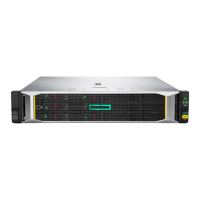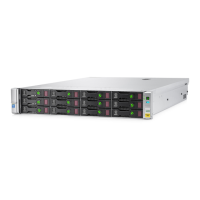Application server Application server
HP StoreVirtual
storage node
HP StoreVirtual
storage node
HP StoreVirtual
storage node
HP StoreVirtual
storage node
Switch A
Switch B
Switch C
Switch D
Hyper-V/vSphere FOM
Site/Rack 1 Site/Rack 2
Site/Rack 3
HP StoreVirtual
Multi-site Cluster
18
Technical white paper | HP StoreVirtual 4000 Storage
Multi-site cluster networking requirements
Multi-site clusters in HP StoreVirtual enable block level synchronous data replication between sites using Network RAID.
Site-awareness for server and storage systems is built in to multi-site clusters. A multi-site cluster can have up to three
sites. As volumes in a multi-site cluster span all sites, each site has the same number of storage nodes and volumes
in these environments should always be protected using Network RAID (Network RAID 10 for clusters with two sites;
Network RAID 10+1 for clusters stretching three sites).
Figure 7. Typical multi-site cluster environment
The multi-site cluster conguration in gure 7 is typical for customers who want to replicate data synchronously between
two data center. HP StoreVirtual Fail-over Manager, which is ideally installed in a third site, provides quorum in the event
of a site failure. For more information, please refer to the Specialized Manager section in the HP StoreVirtual User Guide.
From a networking standpoint, there are various options to achieve resiliency, it is however recommended to use
multiple, aggregated links between data centers.
The two primary factors that contribute to the health of a multi-site cluster are network latency and bandwidth. High
network latency is a primary cause of slow I/O performance, or worse case iSCSI target disconnects. When designing
a network for multi-site clusters, latency should be kept to a minimum; HP recommends a round trip latency of less
than two milliseconds (2 ms). Focus on reducing latency throughout the design from end-to-end, while taking into
consideration the following:
• Distance between sites—make certain distance between all clustered sites meets the 2 ms requirement
• Number of routed hops between sites—each router or switch in the data path adds delay as the packet is received,
processed, and then forwarded
• Advanced network features—rewalls, NAT devices, QoS, or access lists add latency

